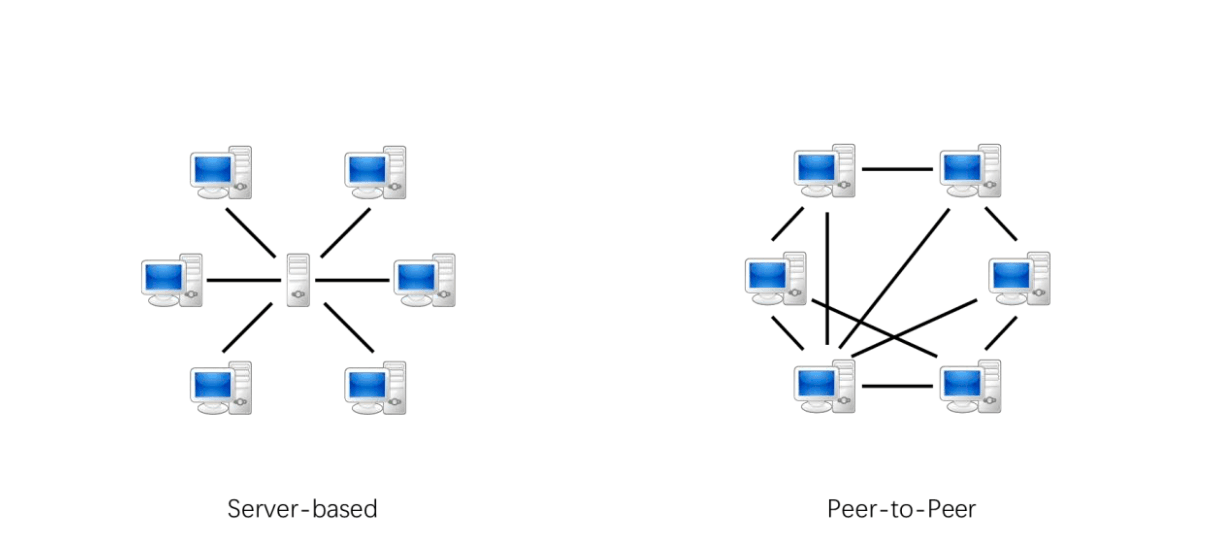Peer-to-Peer (P2P) networks have emerged as a powerful alternative to traditional centralized content distribution systems. This blog post delves into the concept of P2P networks, their advantages, challenges, and applications in modern technology.
What is a P2P Network?
P2P, short for Peer-to-Peer, refers to a decentralized network architecture where each node (or peer) in the network acts both as a client and a server. Unlike traditional client-server models, P2P networks distribute resources and workload across all participants, creating a more resilient and scalable system.

As shown in the image, while server-based networks rely on a central server to manage all connections, P2P networks allow direct communication between peers, eliminating the need for a central authority.
Key Characteristics of P2P Networks
- Decentralization: No central server controls the network, reducing single points of failure.
- Scalability: As more peers join, the network's capacity increases.
- Resilience: The network continues to function even if some nodes fail or leave.
- Resource Sharing: Peers contribute their resources (bandwidth, storage, processing power) to the network.
- Cost-Effective: Reduces the need for expensive central infrastructure.
P2P vs. CDN: A Comparison
While Content Delivery Networks (CDNs) have been the go-to solution for content distribution, P2P networks offer an alternative approach. Let's compare these two technologies:
| Aspect | P2P | CDN |
| Setup Cost | Low | Relatively High |
| Scalability | Improves with more users | Limited by infrastructure |
| Reliability | Resilient to individual node failures | Potential for partial service disruption |
| Sudden Traffic Spikes | Handles well | Handles well |
| Service Quality | Generally good, but can have slow starts | Consistently good |
| Network Resource Usage | May involve redundant data transfers | Efficient use of bandwidth |
| Manageability | Challenging | Easier |
| Security | Potential client-side vulnerabilities | High |
| Copyright Issues | Significant concerns | Easier to control |
| Client Software | Required | Not typically needed |
| Network Maintenance | Simple | Complex |
Applications of P2P Networks
P2P technology has found applications in various domains:
- File Sharing: BitTorrent, eMule
- Cryptocurrencies: Bitcoin, Ethereum
- Blockchain Technology: Distributed ledgers
- Streaming Services: P2P-assisted video streaming
- Communication Tools: Skype (in its earlier versions)
- Distributed Computing: BOINC projects
Advantages of P2P Networks
- Reduced Server Costs: By distributing the load across peers, P2P networks minimize the need for powerful central servers.
- Improved Scalability: The network's capacity grows with the number of users.
- Enhanced Resilience: No single point of failure means the network can withstand significant disruptions.
- Efficient Resource Utilization: Leverages idle resources of participating nodes.
- Lower Bandwidth Costs: Reduces the burden on any single node for content distribution.
Challenges and Considerations
Despite their advantages, P2P networks face several challenges:
- Security Concerns: The decentralized nature can make it difficult to control malicious activities.
- Copyright Issues: P2P networks have been associated with unauthorized sharing of copyrighted material.
- Quality of Service: Performance can be inconsistent, especially when starting up or with limited peers.
- Network Overhead: Maintaining the P2P network structure can introduce additional complexity.
- NAT Traversal: Peers behind firewalls or NAT may face connectivity issues.
The Future of P2P: Hybrid Solutions
As technology evolves, we're seeing the emergence of hybrid solutions that combine the strengths of P2P networks with other technologies:
P2P-CDN Hybrid Systems
Companies like Tencent Cloud with their XP2P service are pioneering hybrid systems that leverage both P2P and CDN technologies. These systems aim to:
- Reduce bandwidth costs associated with traditional CDNs
- Improve content delivery speeds, especially for popular content
- Enhance scalability for sudden traffic spikes
- Provide more reliable service by combining centralized and decentralized approaches
P2P in Edge Computing
The rise of edge computing presents new opportunities for P2P networks:
- Facilitating device-to-device communication in IoT ecosystems
- Enabling more efficient data processing and sharing at the network edge
- Reducing latency in real-time applications
P2P in Decentralized Finance (DeFi)
The principles of P2P networks are at the core of many blockchain-based financial systems:
- Enabling trustless transactions without intermediaries
- Supporting decentralized exchanges and lending platforms
- Facilitating cross-border payments and remittances
Conclusion
P2P networks represent a paradigm shift in how we think about content distribution and resource sharing on the internet. While they come with their own set of challenges, the potential benefits in terms of scalability, cost-effectiveness, and resilience make them an attractive option for many applications.
As we move towards a more decentralized internet, P2P technologies are likely to play an increasingly important role. The integration of P2P principles with other technologies like CDNs, edge computing, and blockchain is opening up new possibilities for efficient, scalable, and resilient network architectures.
Whether you're a developer considering P2P for your next project, a business looking to optimize content delivery, or simply a tech enthusiast, understanding P2P networks is crucial in today's interconnected digital landscape. As the technology continues to evolve, we can expect to see even more innovative applications of P2P principles shaping the future of the internet.